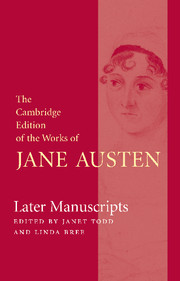Appendix C - ‘Sir Charles Grandison’
Published online by Cambridge University Press: 18 December 2020
Summary
Samuel Richardson's long and popular novel Sir Charles Grandison (1753–4) maintained its popularity to the end of the eighteenth century, reaching its eighth edition in 1796, and prompted a number of abridgements by other authors. The History of Little Grandison, by M. Berquin, published in English translation (from the original French) in 1791, makes no attempt to copy the novel except in the name of the title character and his conspicuous virtue even as a child. However, both The History of Sir Charles Grandison and the Hon. Miss Byron, in which is included the Memoirs of a Noble Italian Family (?1780, 87 pages) and The History of Sir Charles Grandison (1789, 10th edition in 142 pages, 1798) attempt to reproduce a relatively comprehensive account of its complex plot, while devoting most attention to the courtship of Sir Charles and Harriet Byron.
The Austen play concentrates entirely on the Harriet Byron plot, the whole ‘Italian’ section of the novel being represented only by a passing reference to the Lady Clementina (in the novel a serious rival to Harriet for Sir Charles's hand in marriage), and most of the sub-plots hardly mentioned. The Harriet plot, however, is neatly rendered: in Act 1 she goes missing after the masquerade; Act 2 shows the wicked Sir Hargrave Pollexfen attempting to force her into marriage; in Acts 3 and 4, after her rescue by Sir Charles, she meets his family, including his lively sister Charlotte; and Act 5 resolves the action with a double wedding. Scene, character and even turn of phrase very closely follow those of Richardson. For example the play, like the published narrative abridgements, renders in detail one of the most famous scenes in the novel, the attempted forced marriage (vol.1, letter 29): the circumstances of the abduction, the Awberrys, the clergyman and the candles are directly as in Richardson. So is the clergyman's dramatic opening of the wedding service and Harriet's spirited response of ‘no dearly beloveds’ (though this detail is scored through in the play manuscript) and her dashing the prayerbook out of his hand, the squeezing of Harriet in the door and ‘So, I hope you have killed me’, and the removal in ‘a long cloak’ (‘a capuchin’ in the novel, and in the draft of the manuscript, scored through) by candlelight.
- Type
- Chapter
- Information
- Later Manuscripts , pp. 556 - 572Publisher: Cambridge University PressPrint publication year: 2008
- 1
- Cited by

